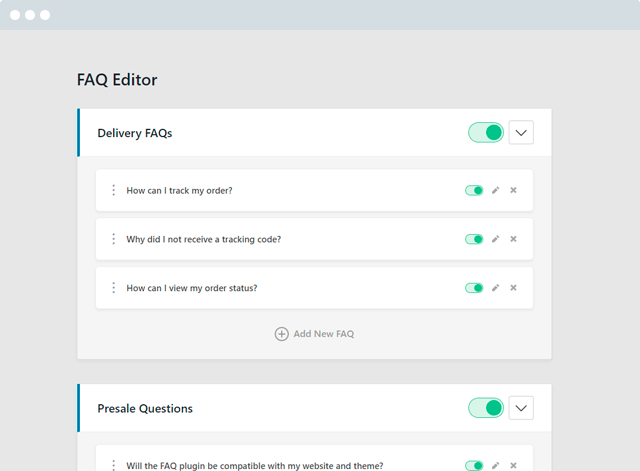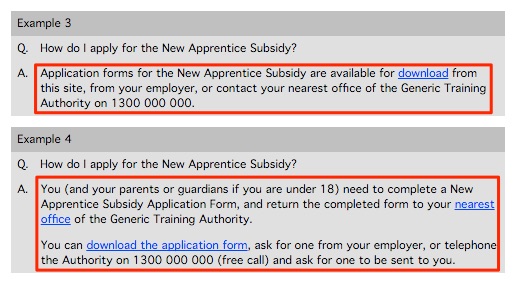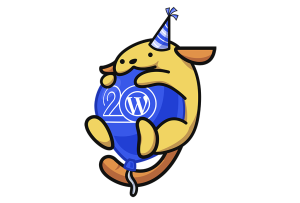Did you know that 41% millennials turn to a site’s FAQs before contacting support?
Yes, almost half of your millennial customers prefer helping themselves before reaching out to your support staff for help. Just imagine how many support tickets, calls, and chat sessions you could save if you only found a way to help these customers right in your FAQs.
And it’s not too hard — the key lies in how you answer your FAQs.
If your answers are helpful, not only will your customers get immediate help, but you will also save a lot of support hours. You could use this time to improve your product or expand your business.
Writing helpful answers isn’t difficult if you follow a few simple ways. Here are 5 that will help you pack a punch with each answer.

Build an FAQ and help answer common visitor questions.
Get the Plugin
1. Start with Who, What, When, Where, How, Why (and Can)
If you’ve noticed, telephone support agents often repeat a question as you ask it. They do so to make sure that they’ve got it right.
The logic is simple: if you understand the question, you give the correct answer.
Likewise, when you sit down to write the answer to the next FAQ you cover, wait. Re-read the question to understand what the user is really asking. Identify the type of the question. By identifying the right question type, you’ll be able to take a suitable approach to answering it.
To understand the different question types and to choose the right approach to answer them, let’s consider an example of a SaaS web analytics software – one that helps webmasters monitor their site traffic and draw insights.
Here’s how some of the sample FAQ questions could look like and the right way to answer them:
Can-type questions – Can questions are easy to answer because they just take a yes or no for the reply.
“Can your product work on multiple domains?”
Approach to the answer:
In our example, if the answer to the question were negative, we could use phrases like, “We do not currently support…” or “Right now this is not possible…but…”
In negative responses, we would try to avoid writing a blatant “No” as the answer.
But if the answer were a “Yes,” we could say so and then add a supporting line that could read something similar to – “Yes, our product works on multiple domains ( followed by conditions if any)…” and then a link to the further instructions for making the product work on multiple domains.
What-type questions – A what-type question shows that your customer is looking for an objective answer. Such a question is like a matter-of-fact kind of a question. So go for a straight and direct answer when replying to what-style questions.
“What are the different payment methods that you accept?“
Approach to the answer:
We could simply list the various available options like PayPal, credit cards, and more.
How-style questions – A how-style question shows that a reader wants to “do” something. When writing the response of a how-to answer, first determine if the answer is short and can be answered right away, or if it would make sense to link to the most relevant article from your knowledge base.
“How can I clear the historic data? ”
Approach to the answer:
If our tool had a simple reset button somewhere on the dashboard, we would choose to give simple instructions to reach that button.
However, if the method of clearing the data were not so straightforward, we would prefer linking to a support article that handled the topic.
Why-style questions – Why questions indicate that your user is just looking to understand why something is the way it is within your product. While answering why-style questions, back up your answer with any source that makes you sound more credible. Also, try to reassure your users if the questions hint at any concerns.
“Why do you need access to my Google Analytics account?”
In our case, we could tell the users that we needed the access to connect our tool with the user’s site’s historic data. Further, to reassure our users, we could state that we never tracked any personally identifiable information.
2. Match the answer with the question
Has it ever happened to you that you got the right answer and still had a hard time following it?
Yes?
Even the right answers fail when they don’t match the style of the question.
Here’s what I mean:
Suppose someone asked you the question, “What’s your name?”. And you answer with, “People call me MyName,” instead of a simple, “My name is MyName.”
When such question-answer style mismatches happen in FAQs, users feel lost.
Kerry Redshaw at Kerryr.net gives a beautiful example of this and how answers fail to make an impact when they don’t align with the question’s style.

3. Stay away from jargon
You know your product and your niche. You also know the power terms in your niche. For example, our technical staff knows the difference between WordPress.com and WordPress.org, we know what APIs mean, we understand integrations and more.
But would it be fair if we answered your queries using this kind of industry-specific vocabulary (or jargon as you may call it)?
No.
And we don’t. When we talk to our customers, we design our talk to match our least-technically skilled customers.
And that’s how even you should craft your FAQ answers. Think about your least-technically equipped customer and answer to him or her. This way, you’ll avoid jargon in your responses, and your users will actually follow your answers.
4. Run your answers through these 3 people
There’s nothing more embarrassing in an FAQ section than inaccurate answers. Even if you’re the best person to answer your users’ FAQs, you could still make errors. To save yourself the hurt that wrong answers can cause, and to write user-friendly answers, pass each answer through the following 3 people from your team:
1. Product Expert
The product expert, well, being an expert will check your answers for accuracy.
2. Customer Support Agent
The customer support agent will give meaningful insights to make your answers more empathetic because support agents are the ones who’re the most exposed to users’ issues. They know the language that users understand as they DEAL with them!
3. Marketer
Passing your answers through a marketer will ensure that no jargon gets through.
5. Format to boost readability
The rules of formatting for readability apply to all forms of web writing, even to FAQ responses.
Use styling elements like lists, bullets, tables, bold, italics and more to break up your text. These will prevent your FAQ answers from looking like walls of text.
Also, add screenshots and videos where required.
Wrapping it up…
You can improve your answers dramatically by understanding what your users are looking for in them. So spend some time on this exercise, and notice how you start writing answers that your users finally benefit from.
Have you ever struggled to follow answers on a site’s FAQ? Do share in the comments below!
The post 5 Simple Ways to Write the Perfect Answers to Your FAQs appeared first on HeroThemes.

